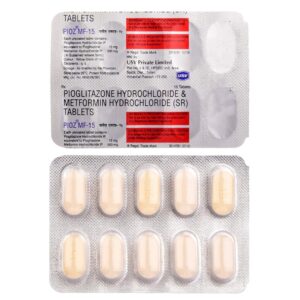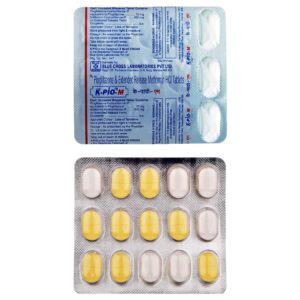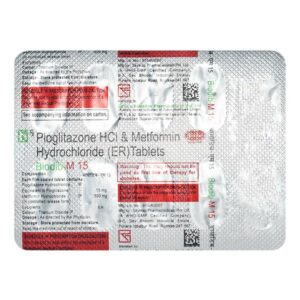METFORMIN + PIOGLITAZONE
Metformin: Metformin is a prescription medication that is primarily used to treat type 2 diabetes. It is also sometimes prescribed for the treatment of prediabetes and polycystic ovary syndrome (PCOS).
The mechanism of action of metformin is to decrease the amount of glucose produced by the liver and improve the body’s response to insulin. It does this by activating an enzyme called AMP-activated protein kinase (AMPK), which regulates glucose production and uptake by cells.
Metformin is usually taken orally in the form of tablets or liquid. The initial dose typically starts at 500 mg or 850 mg once or twice a day, and then it may be gradually increased based on the blood sugar levels and individual response. The maximum daily dose is usually 2000-2500 mg. It is important to follow the prescribed dosing schedule and instructions given by the healthcare provider.
Common side effects of metformin include gastrointestinal discomfort, such as diarrhea, nausea, vomiting, and stomach upset. These symptoms usually occur at the beginning of treatment and tend to improve over time. It is advised to take metformin with food to reduce the likelihood of these side effects. Other rare side effects may include metallic taste in the mouth, low blood sugar (hypoglycemia), and lactic acidosis (a serious condition that requires immediate medical attention, but is very rare).
Metformin is generally well-tolerated, but it may not be suitable for everyone. Individuals with certain conditions, such as kidney or liver disease, heart failure, or allergic reactions to metformin should not use it. It is crucial to consult a healthcare provider for proper evaluation and guidance before starting metformin. Regular monitoring of blood sugar levels and kidney function tests is also recommended during treatment.
Pioglitazone: Pioglitazone is an oral antidiabetic drug that belongs to the thiazolidinedione class. It is primarily used to treat type 2 diabetes mellitus, either as a monotherapy or in combination with other antidiabetic medications.
The mechanism of action of pioglitazone involves improving insulin sensitivity in the body’s cells. It binds to specific receptors called peroxisome proliferator-activated receptors (PPARs) mainly found in adipose tissue, muscle, and the liver. Activation of these PPAR receptors leads to increased transcription of genes involved in glucose and lipid metabolism, resulting in improved insulin sensitivity and reduced hepatic glucose production.
Pioglitazone is typically taken once daily, with or without food. The initial dose is usually 15 or 30 mg, and it can be titrated up to a maximum of 45 mg per day, depending on individual response and tolerability. It is important to follow the prescribed dosage and consult a healthcare professional for any adjustments.
Some common side effects of pioglitazone include weight gain, edema (fluid retention leading to swelling), headache, and upper respiratory tract infection. It may also lead to an increased risk of bone fractures in women. Rare but serious side effects include liver problems, including hepatotoxicity, and an increased risk of bladder cancer. Therefore, patients should regularly monitor liver function and report any symptoms such as abdominal pain, jaundice, or dark urine.
Pioglitazone may interact with other medications, so it’s essential to inform the healthcare provider about all current medications, including over-the-counter drugs and herbal supplements, to avoid potential drug interactions and adverse effects.
Overall, pioglitazone is an effective oral antidiabetic medication that improves insulin sensitivity and helps manage blood sugar levels in people with type 2 diabetes. However, its use should be closely monitored, and patients should be aware of the potential side effects and risks.



